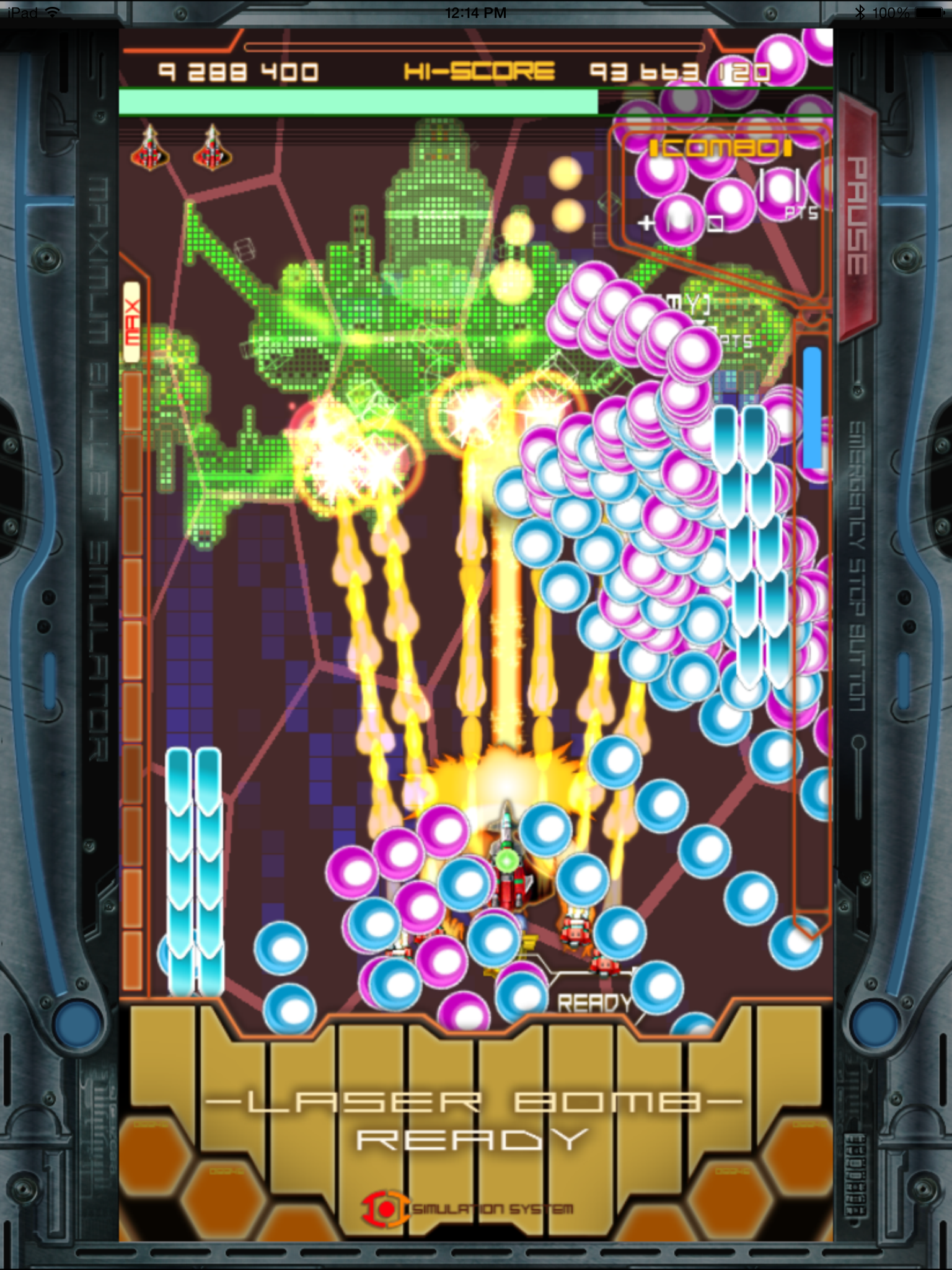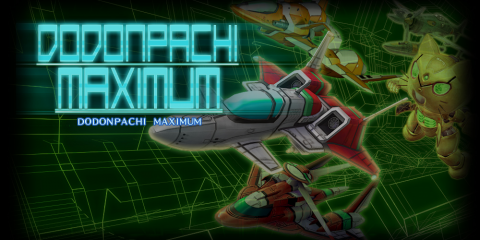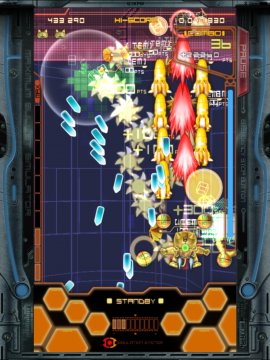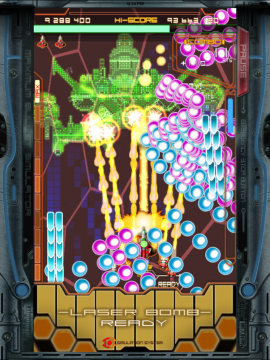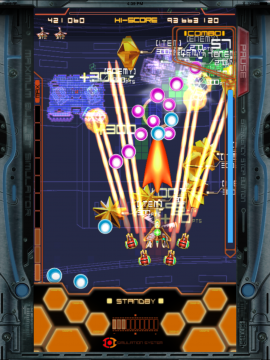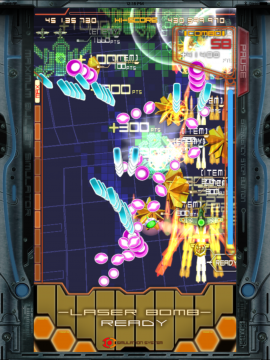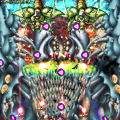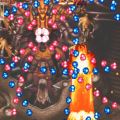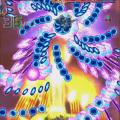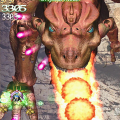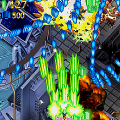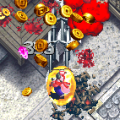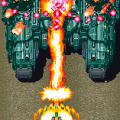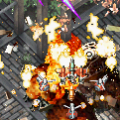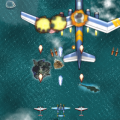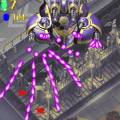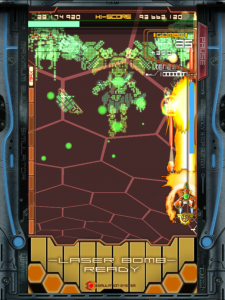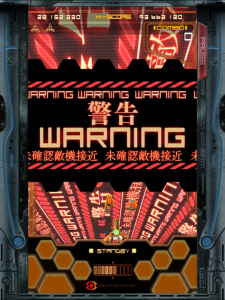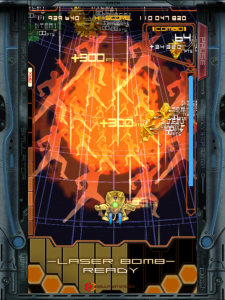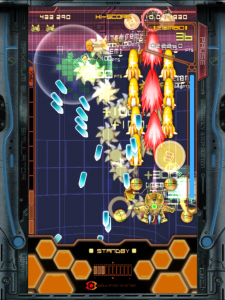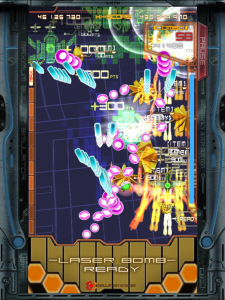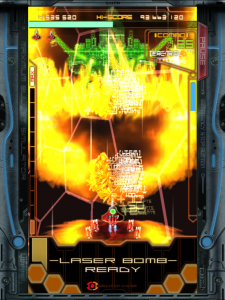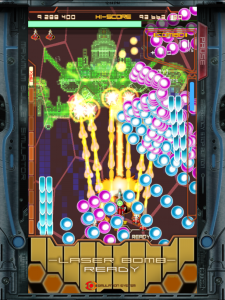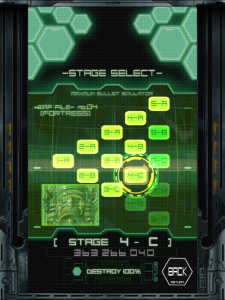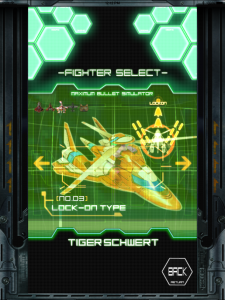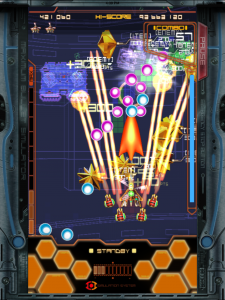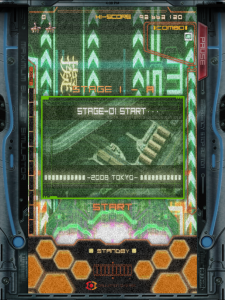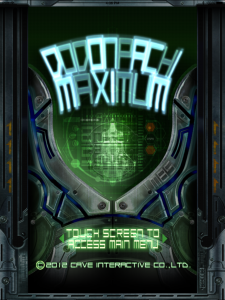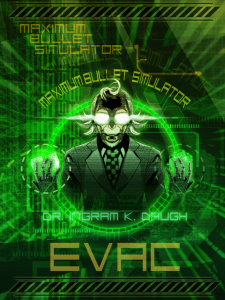After porting several of their arcade titles to mobile phones, Cave finally decided to make a shoot-em-up experience tailor made for smartphones and the current state of mobile gaming. Dodonpachi MAXIMUM is Cave’s the first shmup style game that was designed from the ground up for mobile devices. Originally developed exclusively for Windows Phones, Dodonpachi MAXIMUM breaks away from the traditional DonPachi series’ staples, instead focusing on shorter, more compact gameplay, a simplistic scoring system, and high replay value. Cave focused on having the game act like a simulation, allowing them to reuse existing ideas and patterns from existing games. Cave really took the “simulation” aspect and ran with it, allowing them to make the game a celebration of Cave’s military shmups, and not have to worry about creating a new world and enemy designs, while allowing them to come up with new gameplay systems designed for mobile devices.
Story
The story is very simple, and it actually was not in the original Windows Phone 7 release, but was added into the iOS version when it was released on October 26, 2012. EVAC Industries researcher Dr. Ingram K. Daugh invited the player to have a glimpse at EVAC Industries’ history in developing cutting edge weaponry. To do this, he has created the Maximum Bullet Simulator, or MBS. EVAC Industries (from Ketsui) is having a technology showcase to demonstrate their weapons technology and capability to the world/potential investors, one of whom is the player, who boards the Maximum Bullet Simulator (MBS), where the game takes place.
Characters
Dr. Ingram K. Daugh
The lead researcher at EVAC Industries and responsible for the creation of its overwhelming weaponry.
Tour Conductor
A mysterious person who fully supports Dr. Daugh. Despite her looks, she is quite capable and will everything in her power to ensure that this technology showcase runs smoothly.
1 minute Ray
Wants to sabotage Dr. Daugh’s plans, so that the world will see that she is superior to the Doctor’s weapons. She plans to do this by dropping the simulator’s difficulty level so that anyone can beat it, and in doing so tarnish his reputation. Wears what looks to be a Nintendo Power Glove.
Gameplay
Dodonpachi MAXIMUM serves as a celebration of Cave’s military shooters: the DonPachi series, Ketsui, and Akai Katana, compiling various stages and ships together in a sort of “best of” or “dream match” scenario, allowing players to see how ships from one series would fair if set against a stage from another series. The core gameplay and scoring systems are very simple, removing any sort of power-up items, and score items spawning from enemies as they are defeated. In addition to simply surviving, players are tasked with completing three objectives in each stage, and determine what version of the next stage is unlocked. That’s right, MAXIMUM features branching paths, with more difficult versions of each (sans the first stage). Clearing a stage will unlock the next stage along the same path, but if the player successfully meets at least two of the three requirements in a single run, the harder version of the next stage will unlock instead. Despite being a mobile game, the enemy patterns (especially on the harder levels) are very close to the patterns used in the original games. Additionally, MAXIMUM contains an Easy Mode, which features slower bullets and less dense bullet patterns. The Easy Mode also has its own separate story, with 1 minuite Ray. A nice touch.
In MAXIMUM, players control their ship just like they do in Cave’s other mobile ports. The player’s ship in MAXIMUM will always be firing, and this feature cannot be turned off. There are two different types of weapons in MAXIMUM, the Shot and the Laser. The Laser is generally more powerful, and increases the combo gauge when attacking enemies, but it does not fill the Laser Bomb gauge when destroying enemies like the Shot does. Speaking of, the Laser Bomb is MAXIMUM‘s equivalent to the Smart Bomb / Hyper Laser seen in other Cave shmups. Players can only hold one Laser Bomb at a time. There are two ways to activate the Laser Bomb: by default, the Laser Bomb is activated by pressing two fingers on the screen, or can be triggered automatically if Auto Bombing is enabled and the player has a Laser Bomb ready for use. The Laser Bomb is a powerful blast that attacks every enemy on screen every few frames for massive damage. The Laser Bomb also causes the combo’s HIT counter to skyrocket, due to the “Laser” part of the Laser Bomb. As per usual, the Auto Bomb version of the Laser Bomb lasts for a much shorter duration than if it was manually triggered. Finally, players can turn the Auto Bomb feature off, as well as change the Laser Bomb trigger to be just one finger touching the screen (sort of an “automatic” option).
There are a total of five ships in MAXIMUM, with each ship hailing from a different game. As a little bonus, each ship uses the original announcer from its original game. The first ship is the “Shot Type” RSF-45 Type-A (From Dodonpachi Blissful Death), and is unlocked by default. The Type-A focuses on using the shot weapon, which results in more Laser Bombs, as the Laser Bomb Gauge is filled by destroying enemies with the Shot. The second ship is the “Laser Type” Delta Sword (The Type A from Dodonpachi Resurrection), and is also unlocked by default. This ship focuses on using the Laser weapon, making it very good for increasing the combo HIT counter, but fills Laser Bomb Gauge at a slower pace than the Type-A ship. The third ship is the “Lock-on Type” Tigerschwert (From Ketsui), and must be unlocked by beating any version of Stage 5 with any ship at least once. This ship is a scoring monster, and is the highest scoring ship in MAXIMUM. Although its Laser only goes 3/4 of the screen, it is very powerful and can rapidly increase the HIT counter. The Tigerschwert’s options act as its Shot, and can be locked onto a target and continue to attack it even if the player decides to shift focus and attack something else with the Laser. The fourth ship is known as the “Bomb Type” Orchid (From Akai Katana), which must be unlocked by beating Stage 5 with the Tigerschwert. The reason this ship is known as the “Bomb Type” is due to its numerous Shot projectiles (focused in front of the ship), with the option and the outermost shot being acting as the Laser. Since destroying enemies with the Shot is what fills the Laser Bomb Gauge, the Orchid therefore excels at filling the gauge the fastest. The fifth ship is the “Variable Type” MX-07 Uoratou (From Uo Poko & Dangun Feveron). This ship was added in the iOS version of the game, and was later made available in the Windows Phone version via an update. Uoratou is an odd ship to use, consisting of two different firing modes that fire either the Shot or Laser exclusively. When the ship is not moving, Uoratou will fire a powerful Laser in front of him, but if the player moves at all, even a tiny bit, Uoratou will switch to firing his Shot weapon. The Shot features five different streams of bullets, three of which fire directly in front of him, and his two options automatically fire towards enemies.
In most shmups, the game’s stages serve as nothing more than a background for the action or provide a theme for the enemies. MAXIMUM is no exception to this observation, in fact, MAXIMUM‘s stages exist for that very reason, yet they are important enough to list each stage individually, as MAXIMUM‘s stages all hail from other games. Although each stage of MAXIMUM comes from a different game, the stage order itself matches that of the original game. For example, MAXIMUM‘s Stage 1, “2008 Tokyo”, is also the first stage of Dodonpachi Resurrection. Likewise, Stage 2 “Battle City” is from Dodonpachi, and is also the second stage in that game. The third stage, “Defensive Line” is the third stage fromKetsui. Stage 4 “Fortress”, is also Stage 4 in Dodonpachi Blissful Death, the stage’s original game. And the last stage, Stage 5 is Dodonpachi Resurrection‘s final stage “The Dividing Road of Fate”.
The enemies, mid boss, and stage boss, are all taken and adapted from the stage’s original game. The enemy placement and bullet patterns attempt to be as true as possible within MAXIMUM‘s system, and for the most part, succeeds in this regard. As a special bonus, successfully completing Stage 5-C, 5-D, or 5-E will have the player face off against Taisabachi/Golden Disaster (from Dodonpachi Resurrection) after defeating the regular boss. And, if players manage to beat him on Stage 5-E, then will then face off against Hibachi (from Dodonpachi Blissful Death). Of course, there is a special round which ends with a face off against Evaccaneer Doom.
Although there the enemies of MAXIMUM come in all shapes and sizes, with the exception of the bosses, enemies only come in three different color types: green, blue, and red. If a player comes into contact with a green enemy, they will lose a life. Players can touch blue enemies all they want with no consequence. Red enemies are indestructible and usually represent pieces of scenery. Running into red enemies will destroy the player’s ship just like green enemies do.
Scoring
Scoring in Dodonpachi MAXIMUM is relatively simple compared to the other DonPachi releases. Actually the scoring system is a combination of DonPachi‘s chaining system and Ketsui-style proximity shooting. MAXIMUM‘s main scoring component is the chaining system, which acts like the GP System from other DonPachi games, with a very generous combo timer. In MAXIMUM, enemies have a specific point value displayed somewhere just outside of the enemy’s sprite. When an enemy is destroyed, the combo timer is refilled, the combo counter is incremented by 1, and the enemy’s point value is then added to the combo’s bonus point value, in addition to having the new value be added to the total score. Hitting enemies with the Laser will increment the current combo’s HIT value, and add 10 points to the combo’s point value, and destroying enemies with the Shot will fill the Laser Bomb Gauge.
In addition to the enemies having a set point value (which is then multiplied by the combo counter) when destroyed, they will also drop a star item that awards additional points when collected. There are three types of star items: small star items worth 100 points, medium star items worth 300 points, and large star items worth 1,000 points. These points are added to the player’s score, as well as the point bonus of the current combo. The closer the player is to an enemy when its destroyed will determine the size of the star item. To create the large star items, players will need to destroy enemies from point-blank range, meaning that memorization of enemy placement and shot patterns are essential if the player wishes to generate them consistently.
That said, the real goal with this game isn’t so much score, as it is making at least two of the three requirements for unlocking the harder version of the next stage. The three requirements are: No Miss (don’t lose a life), No Bomb (don’t use the Laser Bomb), and destroy 100% (destroy all enemies in the stage). Of the three, the No Bomb is the hardest requirement to make, with No Miss being the easiest, as triggering the Auto Bomb does not count as losing a life, although it does count as a bomb. But once the player has used a bomb, there is no reason to hold back and can now use bombs freely throughout the rest of the stage. Now, for scoring, it is dreadfully simple: point-blank every enemy, spaced out properly so that the combo gauge never drops. Note that the combo gauge always drops before and after a mid-boss or boss encounter, but does not drop when using a Laser Bomb.
Music
Much like the game itself, the music of MAXIMUM consists of remixes of each stage’s specific track from their original game. The original music was composed by Manabu Namiki, Azusa Chiba, and Yoshimi Kudo, of Basiscape, with Tetsuro Sato, otherwise known as WASi303, remixing and arranging their tracks for MAXIMUM. Overall, MAXIMUM‘s OST is very bass-heavy, too bass-heavy, in fact. The original track’s melodies and main musical lines are present, but they are drowned out by the overwhelming bass. Additionally, the tracks just seem too…safe. Perhaps this is due to the bass, but the tracks have this feeling of just “going through the motions” with no real heart or emotion put into them. The Stage 3 track “Inception” (from Ketsui) is one of the few tracks to escape this trend, but only due to the original’s simple, yet effective melody and backing track. Other tracks such as Hibachi’s remix retains its blisteringly fast tempo, but it no longer has its “hyper-aggressive, in- your-face” feel that propelled the encounter to an even higher level of insanity.
Final Thoughts on MAXIMUM
For a mobile outing, MAXIMUM hits the necessary marks. The game is broken up into smaller segments of various lengths, allowing players to play according to how much time they have available. And due to the branching path and ranking systems, the game offers an incentive for replaying stages multiple times, and rewards players for doing so with more challenging gameplay. The rank system itself is fair as well, only requiring players to achieve two of the three possible requirements to unlock the harder path. There is also an easy mode for players who are not as skilled at shmups, or just want less of a challenge than the standard offering. Still, the bright colors can cause eye strain after even medium length sessions, especially when closing the game and doing something else. This effect is not quite like the “Tetris Effect”, but feels more like the player’s eyes need to readjust into “normal operation” from the optical overload MAXIMUM was unleashing upon the player. The game is great fun, and the simplistic gameplay systems combined with the ability to pilot different ships on numerous stages from different Cave games is a real treat, and very enjoyable.
Links:
Dodonpachi MAXIMUM Official Site
MAXIMUM Interview A fantastic interview with early prototypes
Hibachi Gameplay A video showing Hibachi at the end of Stage 5-E
Easy Mode Special Round Clear MAXIMUM’s hidden secret stage with TLB Evaccaneer DOOM
MAXIMUM OST on YouTube Tracks 17 to 32 are from the MAXIMUM Soundtrack
